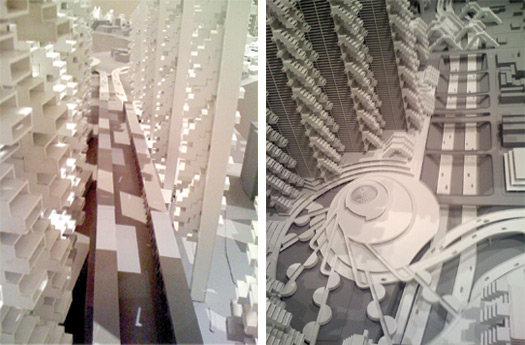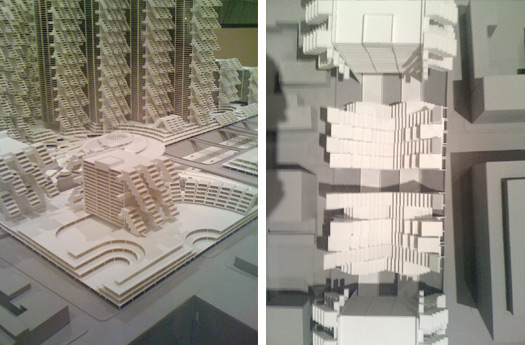
Does anything not look great as a model? For an exhibition at Cooper Union, architectural students have knocked up an enormous one of Paul Rudolph’s proposed Lower Manhattan Expressway (aka LOMAX or LME) and it’s a glorious nightmare. The model was created from Rudolph’s drawings for the project, unearthed by co-curators Jim Walrod and Ed Rawlings, which convey the same sense of shock and awe. (They are also on view.)
Rudolph took up the project, originally proposed by Robert Moses and blessedly halted by near universal opposition, at the behest of the Ford Foundation, in 1967. Where Moses proposed an elevated highway, Rudolph envisioned a trench straddled by a series of prefab, plug-in megastructures. The idea was to link the Holland Tunnel on the west side with the Manhattan and Williamsburg bridge crossings on the east. In plan it has the shape of an enormous Y, with Broome as the stem and Canal and Delancey the branches. While it is architecturally more interesting than anything Moses had in mind, the effect would have been similar: wholesale demolition along the construction corridors and a walling off of entire areas of the city. As Yael Friedman writes over on Urban Ominbus, “if you have lived in New York for any significant amount of time, the moment you fully comprehend what it is you are looking at in the exhibit, the drawings become utterly jarring.”
The extraordinary model, I’d say, is even more jarring and as much for what it does not present: the Lower East Side, which would have been canonized between the project’s two eastern branches. One of the shortfalls of this small exhibition — and I hate to nitpick, because it is truly remarkable — is that there is no attempt to supplement Rudolph’s vision with contextual maps, drawings or images of what it would replace. It is, in any case, something to see — an extraordinary vision, if not a practical one and an interesting counterpoint to the Small Scale, Big Change exhibition now at MoMA, that seems almost a rejoinder to the grand ambitions of modernisms past. LOMAX certainly was that.

